Mariel Capanna and Stella Zhong in conversation upon the occasion of their solo exhibitions on view at Adams and Ollman July 9–August 27th, 2022.
Stella Zhong: I have been building spaces hidden within my sculptures where entirely made-up, secret worlds reside. These areas are either in the bottom or the back of a piece, or on the very top above normal height, so crouching down or jumping may get you a partial view into these worlds and sometimes not at all.
Recently, I was asked what I would call these "worlds/things" underneath/above my structures, and I realized I have never had a name for them. Even to vaguely say that they are between places, words, objects, numbers, or beings feels inaccurate. I make the individual units (the little clay balls and cubes, etc.) that make up the sprawling landscape of my sculptures like the production of buttons or nails. Then when they are placed in the work their roles and relationships become extremely precise. This precision is measured against something I can't quite pinpoint. I stop working on them when I feel like I've become a stranger, a visitor who's trying to decode information and history from them.
Your paintings often come to mind when I look out onto surrounding rooftops dotted with seemingly unconnected objects, half visible or half submerged. I always look for things that seem to not belong—I do that when looking at your paintings too! In your newer works, there's also an absence of the ground but there are gravities. I feel connected to that. I try to get that feeling in my work. Sometimes a string becomes the heaviest among all the things. What do you call the clusters of objects in your paintings?
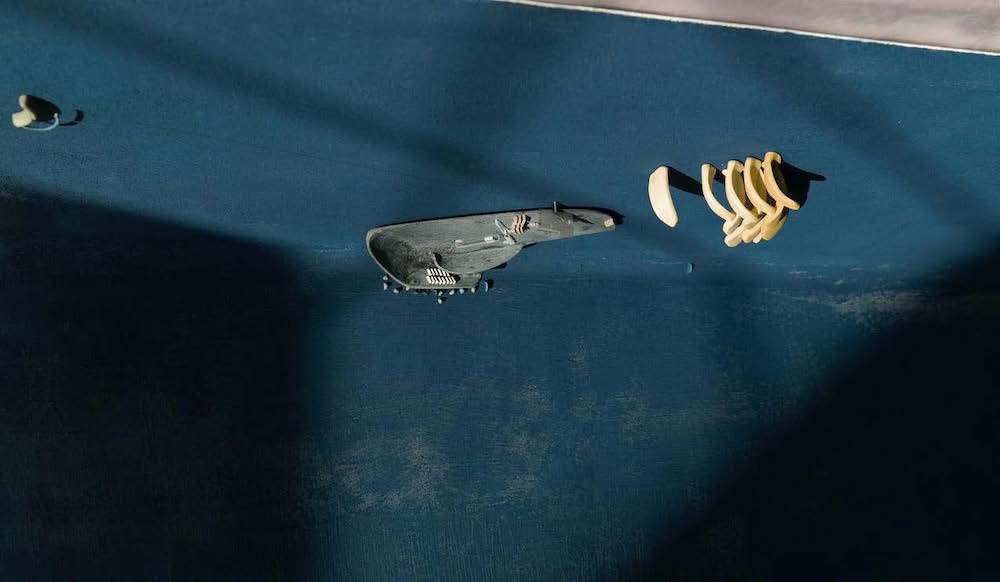
Detail from Spontaneous Unmixing of Static and 1/3s is Never Observed, 2022 at SculptureCenter.

Detail from Spontaneous Unmixing of Static and 1/3s is Never Observed, 2022 at SculptureCenter.

Detail from Spontaneous Unmixing of Static and 1/3s is Never Observed, 2022 at SculptureCenter.

Los Angeles. Photo: Stella Zhong.

Stella Zhong’s studio. Photo: Stella Zhong.
Mariel Capanna: I welcome this prompt to give the clusters a name! A few months ago in a used bookstore in Doylestown, PA, my husband stumbled upon James Lipton’s An Exaltation of Larks, a compendium of “terms of venery” including a “gaggle of geese” or an “ostentation of peacocks” or a “shrivel of critics.” To date, if I’ve ever referred to the shapes in my paintings collectively, I’ve called them what you called them—“shape-clusters.” But like you with your buttons and nails, I have some analogies in my pocket. Lately I’ve been thinking of them like fistfuls of confetti tossed into the air or like soap flakes settling in a snow globe—lightweight things, easily carried and tossed by external forces like shifting winds or waters. Or sometimes I think of these shapes as things that have flight, like a murmuration of starlings or a flutter of migrating monarchs ready to land. A toss of shapes? A flutter of shapes? Maybe I should find a more particular word for "shapes" too.
It’s true—the view in my recent paintings has shifted up and away from the ground. All of my shapes used to feel pinned or stitched or pasted or collaged in place beneath a horizon line. Your observation about gravity helped me realize that when everything was tethered to the ground in my paintings, relationships between shapes were very precise. Now that everything is tossed into the air, all shape-relationships are in flux and things tend to be drifting apart unless they’re gathering together toward the bottom edge of the painting, like sleet on a windshield. Can you tell me more about the pull of gravities in your work? About weight and lightness? About your NASA Zero Gravity experience last year?

Detail: Mariel Capanna, Cotton Field, Sampler, Milk Jug, Porch, oil on panel, 10x13 inches, 2017.

Detail: Mariel Capanna, Sash Lock, Lightbulb, Hay Bale, Swan, oil, marble dust and wax on panel, 12x9 inches, 2021.
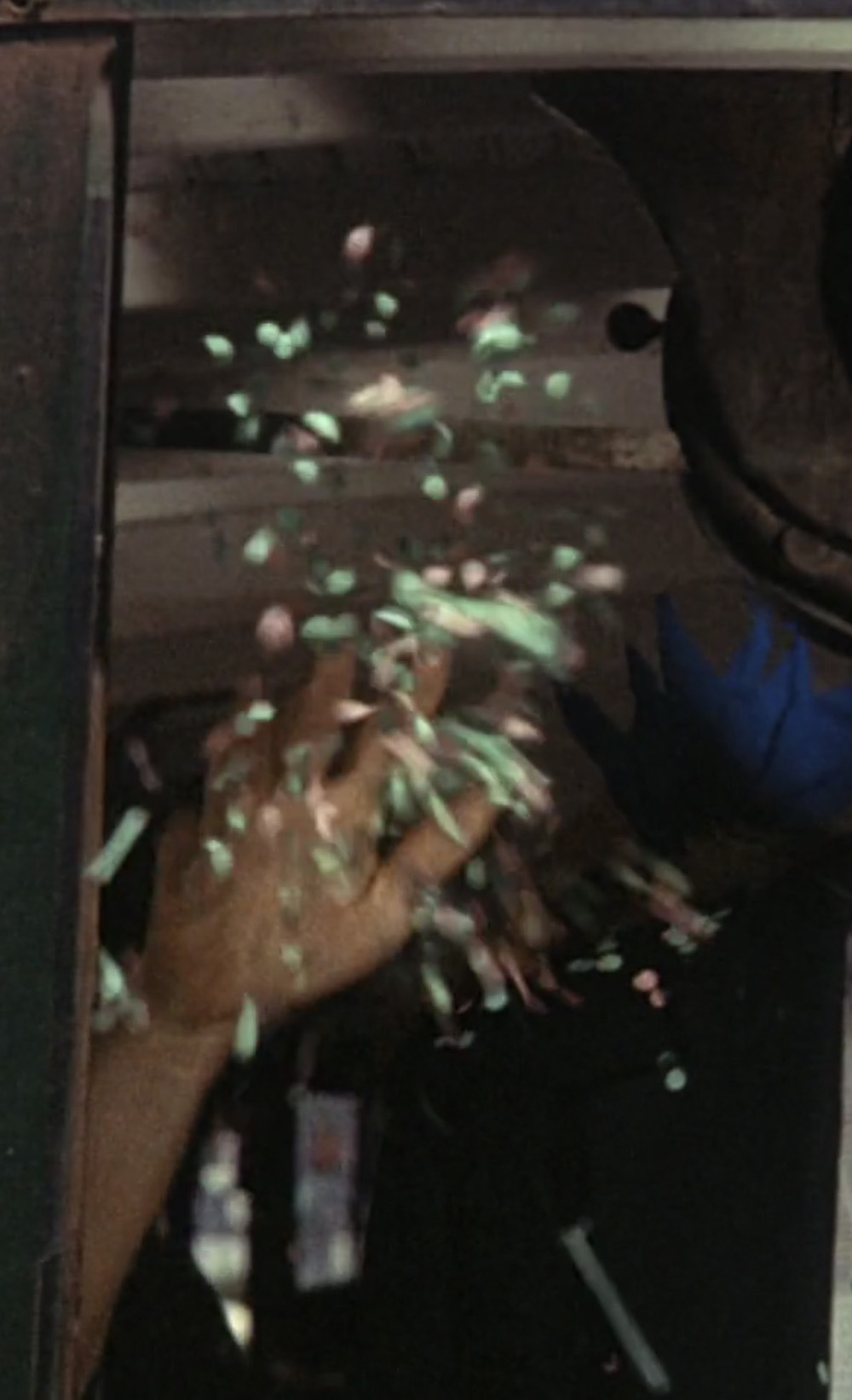

Film Stills from Orfeu Negro, Dispat Films/Gemma/Tupan Films, 1959.
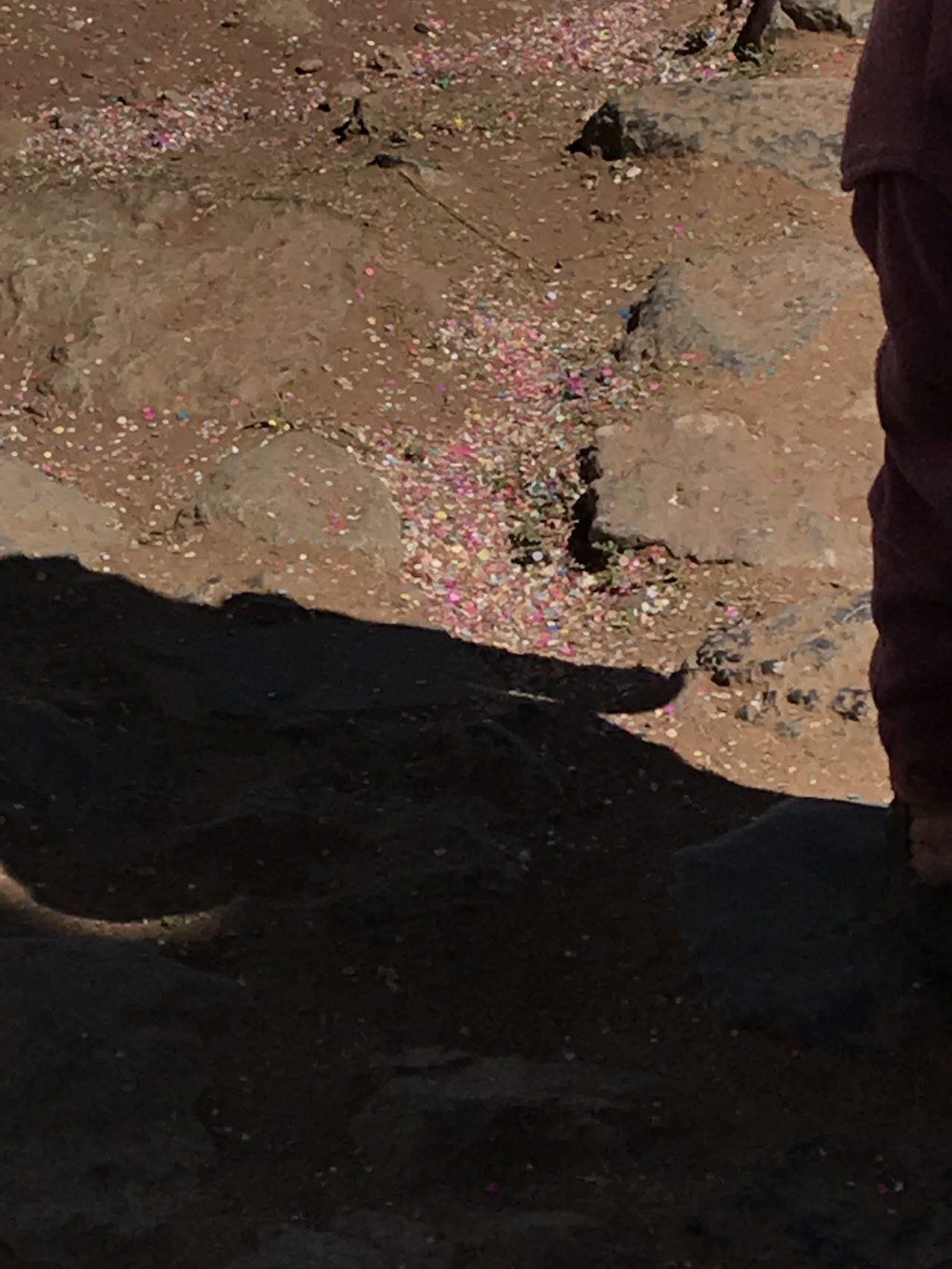
Plaza de Armas de Chinchero, Chinchero, Peru. Photo: Mariel Capanna.
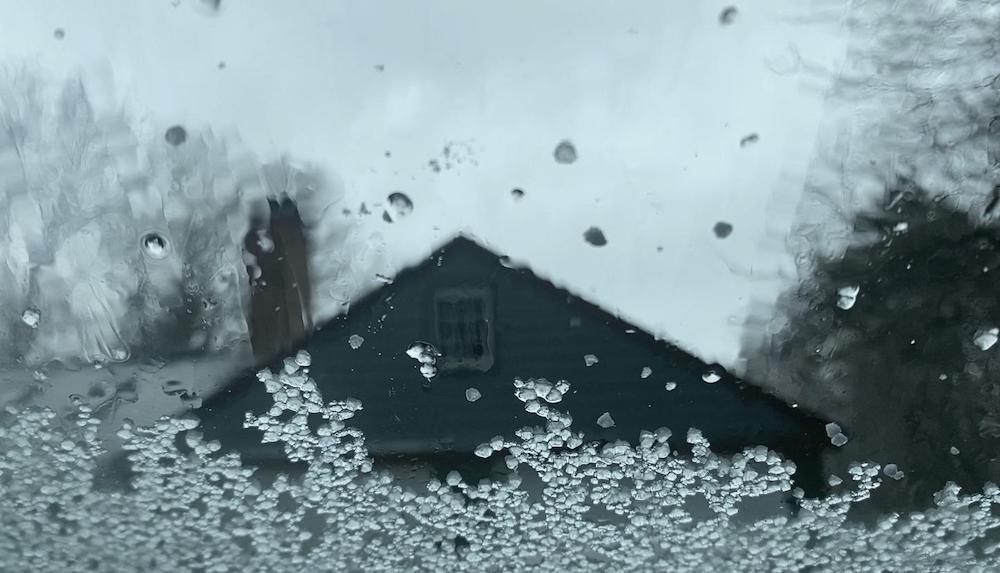
Bennington, VT. Photo: Mariel Capanna.
SZ: A toss of shapes! I love that. Now that you mentioned the Zero Gravity flight, what happens on the plane during zero gravity looks just like your paintings: a toss of object-human-shapes. While floating next to someone’s stuffed animal and globs of water, I felt an equalizing of meaning and weight, that I am no different from a little bubble. And I giggled a lot, from feeling a true empathy with tiny, potentially lifeless things. Spotting a sock in your painting gave me a similar hehe moment.
“[R]ecently electricity, ultrasound, and waves have been very present albeit fictitiously extant in my work in forms like strings, paper, mesh. … I think about how these intangible forces carry information and cut through gravity.”
—Stella Zhong
I don't think I consider gravity directly most of the time. I am tuned into the other forces that pull against it or are free of it; recently electricity, ultrasound, and waves have been very present albeit fictitiously extant in my work in forms like strings, paper, mesh. … I think about how these intangible forces carry information and cut through gravity. And they lead me to a dimension where I see everything as a temporary combination of atoms. The small objects feel like an enlargement of the various atomic processes: grouping, splitting, reconfiguring...

Detail from Spontaneous Unmixing of Static and 1/3s is Never Observed, 2022 at SculptureCenter.
Do you think about painting fluttering objects as a grounding practice or one that untethers you more? I am curious because I’ve recently discovered that I work very much like a painter. I treat the spaces or structures that I build like canvases. Even though I put a lot of care and intention into their creation, they are not specific until the small objects populate them. My process is pinpointing something within a blurry field, then finding a location that perhaps grounds or triangulates the planar/planetary shifts that you observed. I like what you said about intimacy and distance. It's a strange feeling—my favorite—to feel extremely close to something unreachable and perhaps unknowable.
“It’s a strange feeling—my favorite—to feel extremely close to something unreachable and perhaps unknowable.”
—Stella Zhong
Thinking about light, my head is often split between outer space and subatomic space. In both places, light doesn't penetrate the same way as in an oxygen atmosphere. I guess it's supposed to be very dark. I don't know where my light comes from. The atmospheres portrayed in your work are in-between time to me. It tells me that I am standing at a particular angular position between the sun and earth to be able to access that range of color in the sky. I am interested in this idea that sunset/rise is "fleeting," but it's not true. It's always there, the pink-orange-blue haze is always there, we are the ones that rotate into the visible zone and have to rotate out of it.
MC: Wow, Stella! Thank you for pointing out what I now recognize as obvious—that the colors of sunrise and sunset are always there, and that we’re always rotating toward or away from them. Until now, I have thought of that pink-orange-blue light-condition as “fleeting.” And fleetingness has been an important part of my painting process, generally. I’m always working from direct observation of videos or slideshows of images in motion, and it’s for the very fact that these images are fleeting that I feel driven to catch and collect something from them. To “catch” here is maybe to notice and remember for a moment; to “collect” is to make notational marks on my painting.
For a while I treated my source material—say, a found home video—like a whole lifetime with a hard-edged beginning and a hard-edged end. I gave myself the strict rule that when the video ended, the painting had to be finished. I felt an urgency to see as much as possible and to paint as quickly as possible, since anything that I missed on the screen would be lost to the painting. But over the past few years, I’ve relaxed those time constraints and I’ve been treating my source material more like a day that will be followed by another; I let myself watch the same thing over and over again until the painting feels finished. Working this way, I can trust that whatever I miss once, I might catch on a second or seventh or eighteenth viewing. It’s like knowing that the sun is going to rise again and give me another chance. I’ve always thought of my paintings as having a shifting point of view, but I’m realizing that there’s something about my logic that still assumes a fixed position in relation to the sun. Maybe that’ll change thanks to this exchange. I like the idea that the paintings can chase or follow the pink-orange-blue.
Is painting these fluttering things grounding or untethering? Sometimes it can make me feel frantic, trying to observe too many things at once. But if I soften and generalize my attention, I can usually manage to attend to one thing and then another, and then another. So at its best it’s maybe both: it makes me feel light, nimble, flexible (untethered), but also sturdy and sure (grounded). The paintings are built one little object/shape at a time, and if those shapes feel too disparate I’ll connect them with something thin like a string, a ribbon, a streamer, a bow. Maybe these lines of mine play a similar role to your strings and mesh—they’re delicate forces that hold things and spaces together.
I notice that when objects are tucked into holes or crevices in your sculptures, or when things are nestled behind curved surfaces, I think of them as hiding or seeking privacy. Do you always have a sense of what’s happening in each nook of your work? Or are some things somehow private, kept secret even from you?
![]()
Detail: Mariel Capanna, Rooftop, Ladder, Lightbulb, Clock, oil, chalk, and wax on panel, 24 x 30 inches, 2022.
![]()
Detail: Mariel Capanna, Candles, Kite, Ball, Birds, oil, chalk, and wax on panel, 56 x 52 inches, 2022.
“With all of my paintings, I’m asking: when strung together, can a series of incomplete views, clunky translations, misremembered moments, flattened experiences, and oversimplifications yield something new that’s still meaningful in its own right?”
SZ: Privacy is something that I have been thinking a lot about and there are many layers to it. I am interested in privacy as individuals, in anonymity; I am interested in our private minds that we can't even fully access; I am interested in agency beyond human's. I usually have a pretty good sense of the geography of the spaces I'm building. What goes on within these spaces evolves from the build-excavate process I mentioned earlier. I enjoy this part a lot because it always feels out of body, it feels like I am an outsider trying to piece together something of a different time/logic or trying to solve a math problem. There are moments when what I made becomes completely unknown to me, and that's when I usually stop. I guess these objects' privacy is protected both from hiding and from being themselves, coded through a few rounds of translation.
Taking objects from movies and pictures, do the stories remain with the objects you pick out? Does a painting become a collage of multiple parallel and intersecting narratives which only you would probably know? Are they your secrets?
I like how your paintings are "built one object/shape at a time." I share the same rhythm. I often tell people that I build simultaneously as I excavate—two opposite actions at the same time. It means that I am always only seeing the partial picture. Intentions and surprises continuously counter one another. You are totally right about the role of strings and mesh in my little worlds: to hold, to point, to transmit.
In terms of the rendering of things, do you ever think about cuteness, cartoon? It's a question I get asked sometimes, specifically about my small objects that are usually nondescript but read as cute. There's a level of cartoon-like quality to your painted things, too. They are not entirely realistic and are simplified both in shape and color. Perhaps it's a way to secure memory without overcrowding with details? Perhaps this is how the world exists in your consciousness? This makes me think about virtual reality. You've conjured a parallel reality that's two degrees off from the one we physically live in, but it doesn't require much struggle to be versed in that new one either.
Here's an annoying question for you: when do you know when a work is done!? Not something that I am particularly concerned with but curious if it's on your mind.
“The paintings are built one little object/shape at a time, and if those shapes feel too disparate I’ll connect them with something thin like a string, a ribbon, a streamer, a bow. Maybe these lines of mine play a similar role to your strings and mesh—they’re delicate forces that hold things and spaces together.”
MC: My painting practice involves accepting that I am, as you put it, “always only seeing the partial picture;” accepting that if I’m focusing on one thing, then I’m necessarily failing to see everything else—or at least failing to see everything else in any kind of detail. My painting practice also involves accepting that I’m always only partially remembering that partially seen picture. The cartoonish quality that you identified is mostly the result of the limitations of my memory. When I’m watching a video, I’ll see a pale blue bicycle and I’ll remind myself: “pale blue bicycle, pale blue bicycle”—but then when I reach out to paint it, I’ll hardly remember the proper shape of a bicycle so I’m forced to simplify it. Or I’ll see a beautiful boot with a bit of sock sticking out and I’ll think “brown boot with yellow striped sock, brown boot with yellow striped sock” and then that’s what I’ll paint, but it will certainly have lost the particular charm and character of the brown boot that I first noticed and cared to paint. That can be dissatisfying in the moment—I’m often disappointed by or critical of that cartoonish quality—but then that brown boot in its simplified form will, in my painting, form some surprising relationship with, say, the simplified shape of the pale blue bicycle, and then I no longer crave for my painted brown boot to be a faithful rendering of that original idiosyncratic brown boot. With all of my paintings, I’m asking: when strung together, can a series of incomplete views, clunky translations, misremembered moments, flattened experiences, and oversimplifications yield something new that’s still meaningful in its own right?
Another thing that leads to cartoonishness is my speed of painting (i.e. fast). Painting quickly, there’s no time for me to render shapes carefully, which leads to simplification. But it’s funny, when I’m painting very very quickly, there’s still no time for careful rendering but there’s also no time for clean-edged simplification. My brushstrokes become clunky and paint application thickens. At that quickest speed, my paintings seem to lean back away from cuteness, because (maybe) my quickest marks are less identifiable, less nameable, more abstracted.
![]()
Detail: Mariel Capanna, Trees, Snow, Crowd, Sky, oil, marble dust, and wax on panel, 20 x 16 inches, 2022.
In graduate school, my final studio project (ultimately unfinished due to COVID) was a series of negative shapes—wall-shapes, really—pulled from the backgrounds of family photos and applied in lime plaster to the walls of my studio—preparatory work for what was meant to become a fragmented fresco. I’m pretty sure you saw that work-in-progress (I was so happy and honored to see you at my 2020 fall semester final review!). I remember that one of my critics visited my studio while I was working on this and exclaimed “Wow, all the cuteness is gone!”—and this was clearly, to her mind, a positive development. I wonder, how do you feel when “cuteness” comes up? Do you think that associations with cuteness in response to your work are mostly inspired by relative scale? Or is there something else at play?
![]()
Detail: Mariel Capanna, Negative Space, brick dust, riverbed sand, and slaked lime on drywall, concrete floor, and steel door, 2020.
Your question about the relationship between my painted shapes and their source narratives is a good one and, I’m finding, a tricky one for me to answer. There are paintings that I made seven or two years ago whose sources I already forget. Once that’s the case, I’m certainly not a keeper of the painting’s secrets. In other cases, I’m very sure of where the imagery originated, and the painting does have a strong association with that original source. When I can associate the objects with a narrative, I think of them as functioning like an arma christi painting—scattered reminders of disparate scenes that contributed to a linear narrative. When that narrative slips away from memory, the paintings feel to me more like hand-painted corner store signs... the scattered shapes and objects are associated with one another simply because they’re in the same place at the same time. I don’t tend to advertise what my source materials are for a given painting. When I do reveal source materials, the experience of the painting can become too much of a matching game. When I keep the source materials to myself, viewers tend to find their own associations with shapes and objects, and the paintings become familiar in a personal way. So maybe this is a long-winded and reluctant “yes”—they are secrets.
![]() Carmeline Missal of Nantes, Illuminated Manuscript on Parchment, 1471-1476.
Carmeline Missal of Nantes, Illuminated Manuscript on Parchment, 1471-1476.
![]()
When is a work done? I like that, for you, distance, mystery, and a feeling of unknown are the signals. I tend to call a painting done when every mark and every zone has a role in relationship to all the others; when no part of the painting feels stranded, idle, isolated. Sometimes I aim to make a very sparse painting, and when it’s almost feeling finished I make a mark that throws everything off. Then I need to make forty-two more moves in order for everything to work and by that point it’s a very cluttered painting and that’s just what it has to be. My paintings are additive and cumulative, and it’s difficult for me to remove things or edit back. Rewinding isn’t an option. So if I want a painting with ample negative space or open space, I need to build it up very cautiously. Does your building process involve much unbuilding? Undoing and redoing?
I’ve noticed that if I spend a few weeks painting all day, every day, it becomes especially fun to go on walks because I begin to perceive the environment around me as a composition of small scattered shapes, as in my paintings. I become more likely to see, say, a thin brightly colored ribbon caught in a bush, or a distant traffic cone, or the flight of a small bird. Do you catch glimpses of your sculptures and compositions when you’re moving through the world, outside of your studio?
SZ: I do all the time! Just the other day I saw this group of satellites on the corner of a building and thought to myself - that’s my work!
![]()
Los Angeles. Photo: Stella Zhong.
Mariel Capanna (b. 1988, Philadelphia, PA; lives and works in Williamstown, MA) received a BFA and Certificate of Fine Art from the Pennsylvania Academy of the Fine Arts, Philadelphia, PA and an MFA from Yale School of Art, New Haven, CT. She has been an artist in residence at the Guapamacátaro Art and Ecology Residency in Michoacan, MX; Skowhegan School of Painting and Sculpture, Madison, ME; and at the Tacony Library and Arts Building (LAB, Philadelphia, PA). Capanna has also been the recipient of the Robert Schoelkopf Memorial Traveling Fellowship and an Independence Foundation Visual Arts Fellowship. She is currently the Mellon Post-MFA Fellow in Studio Art at Williams College, Williamstown, MA.
Stella Zhong (b. 1993, Shenzhen, China; lives and works in New York, NY) received her BFA from Rhode Island School of Design in 2015 and MFA from Yale University School of Art in 2021. Her work has been exhibited nationally and internationally: at Chapter NY and Sculpture Center in New York, NY; FANTA in Milan, Italy; The Aldrich Contemporary Art Museum in Ridgefield, CT: Galerie Marguo in Paris, France; PEANA in Mexico City, Mexico; Guan Shanyue Art Museum in Shenzhen, China and Hive Center for Contemporary Art, Beijing, China; among others.
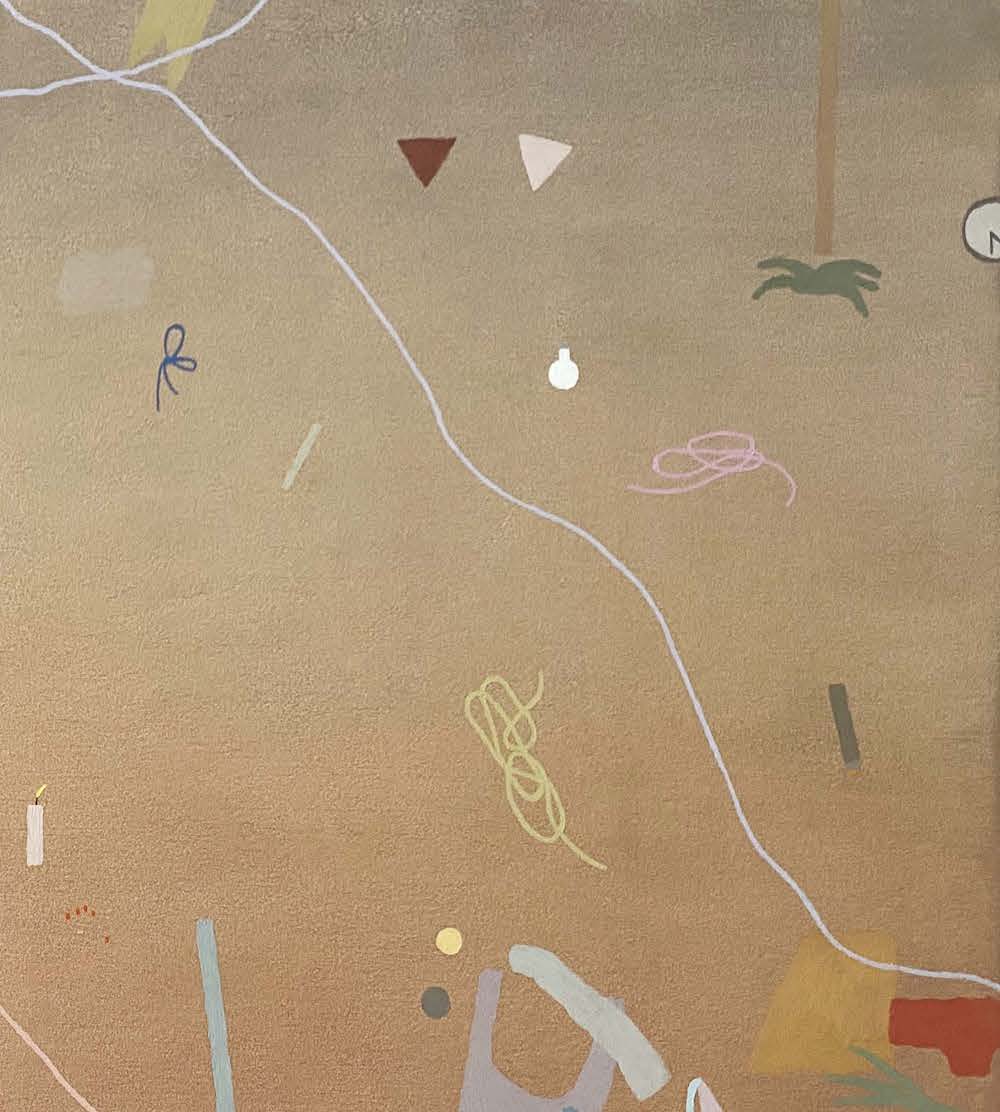
Detail: Mariel Capanna, Rooftop, Ladder, Lightbulb, Clock, oil, chalk, and wax on panel, 24 x 30 inches, 2022.

Detail: Mariel Capanna, Candles, Kite, Ball, Birds, oil, chalk, and wax on panel, 56 x 52 inches, 2022.
“With all of my paintings, I’m asking: when strung together, can a series of incomplete views, clunky translations, misremembered moments, flattened experiences, and oversimplifications yield something new that’s still meaningful in its own right?”
—Mariel Capanna
SZ: Privacy is something that I have been thinking a lot about and there are many layers to it. I am interested in privacy as individuals, in anonymity; I am interested in our private minds that we can't even fully access; I am interested in agency beyond human's. I usually have a pretty good sense of the geography of the spaces I'm building. What goes on within these spaces evolves from the build-excavate process I mentioned earlier. I enjoy this part a lot because it always feels out of body, it feels like I am an outsider trying to piece together something of a different time/logic or trying to solve a math problem. There are moments when what I made becomes completely unknown to me, and that's when I usually stop. I guess these objects' privacy is protected both from hiding and from being themselves, coded through a few rounds of translation.
Taking objects from movies and pictures, do the stories remain with the objects you pick out? Does a painting become a collage of multiple parallel and intersecting narratives which only you would probably know? Are they your secrets?
I like how your paintings are "built one object/shape at a time." I share the same rhythm. I often tell people that I build simultaneously as I excavate—two opposite actions at the same time. It means that I am always only seeing the partial picture. Intentions and surprises continuously counter one another. You are totally right about the role of strings and mesh in my little worlds: to hold, to point, to transmit.
In terms of the rendering of things, do you ever think about cuteness, cartoon? It's a question I get asked sometimes, specifically about my small objects that are usually nondescript but read as cute. There's a level of cartoon-like quality to your painted things, too. They are not entirely realistic and are simplified both in shape and color. Perhaps it's a way to secure memory without overcrowding with details? Perhaps this is how the world exists in your consciousness? This makes me think about virtual reality. You've conjured a parallel reality that's two degrees off from the one we physically live in, but it doesn't require much struggle to be versed in that new one either.
Here's an annoying question for you: when do you know when a work is done!? Not something that I am particularly concerned with but curious if it's on your mind.
“The paintings are built one little object/shape at a time, and if those shapes feel too disparate I’ll connect them with something thin like a string, a ribbon, a streamer, a bow. Maybe these lines of mine play a similar role to your strings and mesh—they’re delicate forces that hold things and spaces together.”
—Mariel Capanna
MC: My painting practice involves accepting that I am, as you put it, “always only seeing the partial picture;” accepting that if I’m focusing on one thing, then I’m necessarily failing to see everything else—or at least failing to see everything else in any kind of detail. My painting practice also involves accepting that I’m always only partially remembering that partially seen picture. The cartoonish quality that you identified is mostly the result of the limitations of my memory. When I’m watching a video, I’ll see a pale blue bicycle and I’ll remind myself: “pale blue bicycle, pale blue bicycle”—but then when I reach out to paint it, I’ll hardly remember the proper shape of a bicycle so I’m forced to simplify it. Or I’ll see a beautiful boot with a bit of sock sticking out and I’ll think “brown boot with yellow striped sock, brown boot with yellow striped sock” and then that’s what I’ll paint, but it will certainly have lost the particular charm and character of the brown boot that I first noticed and cared to paint. That can be dissatisfying in the moment—I’m often disappointed by or critical of that cartoonish quality—but then that brown boot in its simplified form will, in my painting, form some surprising relationship with, say, the simplified shape of the pale blue bicycle, and then I no longer crave for my painted brown boot to be a faithful rendering of that original idiosyncratic brown boot. With all of my paintings, I’m asking: when strung together, can a series of incomplete views, clunky translations, misremembered moments, flattened experiences, and oversimplifications yield something new that’s still meaningful in its own right?
Another thing that leads to cartoonishness is my speed of painting (i.e. fast). Painting quickly, there’s no time for me to render shapes carefully, which leads to simplification. But it’s funny, when I’m painting very very quickly, there’s still no time for careful rendering but there’s also no time for clean-edged simplification. My brushstrokes become clunky and paint application thickens. At that quickest speed, my paintings seem to lean back away from cuteness, because (maybe) my quickest marks are less identifiable, less nameable, more abstracted.
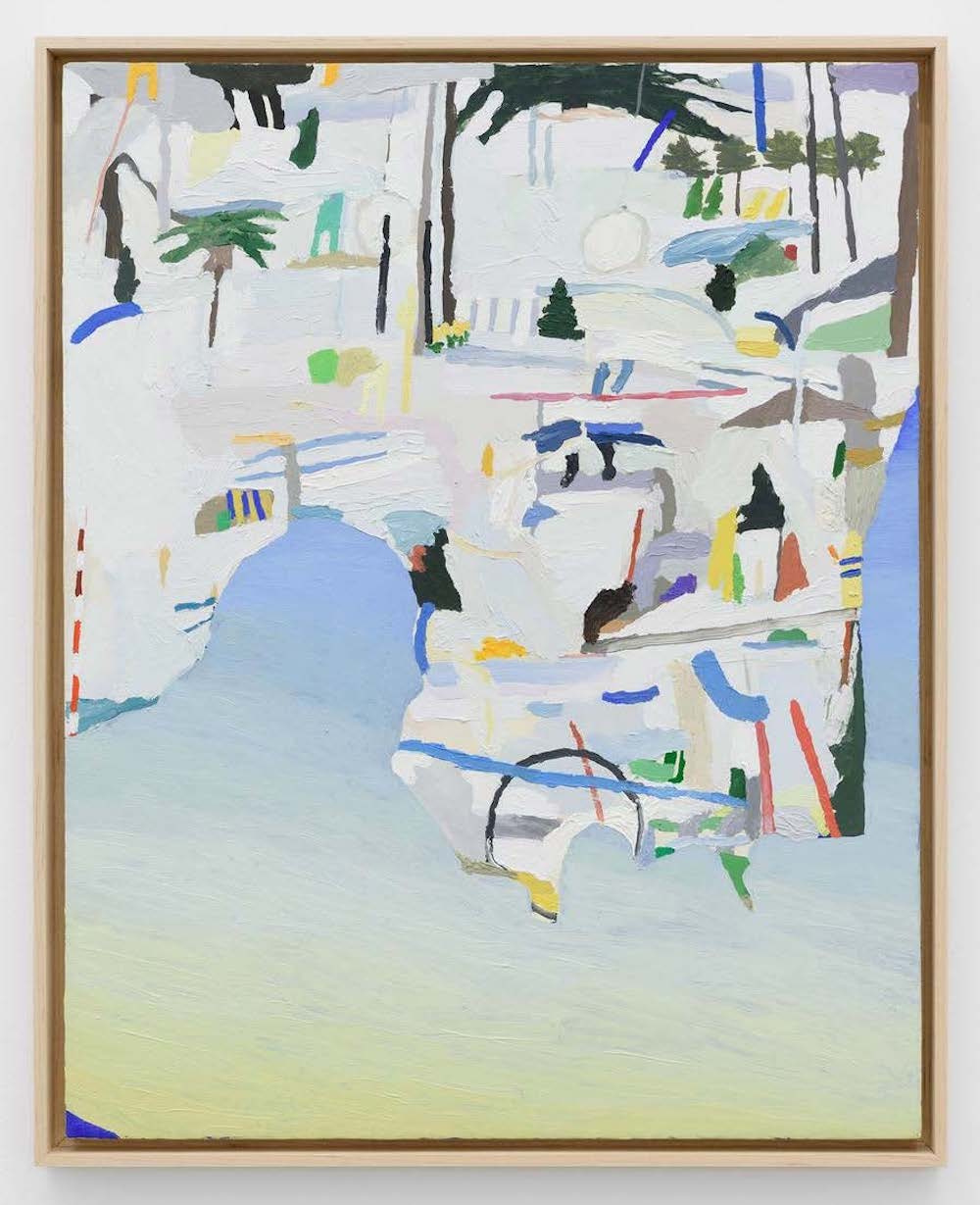
Detail: Mariel Capanna, Trees, Snow, Crowd, Sky, oil, marble dust, and wax on panel, 20 x 16 inches, 2022.
In graduate school, my final studio project (ultimately unfinished due to COVID) was a series of negative shapes—wall-shapes, really—pulled from the backgrounds of family photos and applied in lime plaster to the walls of my studio—preparatory work for what was meant to become a fragmented fresco. I’m pretty sure you saw that work-in-progress (I was so happy and honored to see you at my 2020 fall semester final review!). I remember that one of my critics visited my studio while I was working on this and exclaimed “Wow, all the cuteness is gone!”—and this was clearly, to her mind, a positive development. I wonder, how do you feel when “cuteness” comes up? Do you think that associations with cuteness in response to your work are mostly inspired by relative scale? Or is there something else at play?

Detail: Mariel Capanna, Negative Space, brick dust, riverbed sand, and slaked lime on drywall, concrete floor, and steel door, 2020.
Your question about the relationship between my painted shapes and their source narratives is a good one and, I’m finding, a tricky one for me to answer. There are paintings that I made seven or two years ago whose sources I already forget. Once that’s the case, I’m certainly not a keeper of the painting’s secrets. In other cases, I’m very sure of where the imagery originated, and the painting does have a strong association with that original source. When I can associate the objects with a narrative, I think of them as functioning like an arma christi painting—scattered reminders of disparate scenes that contributed to a linear narrative. When that narrative slips away from memory, the paintings feel to me more like hand-painted corner store signs... the scattered shapes and objects are associated with one another simply because they’re in the same place at the same time. I don’t tend to advertise what my source materials are for a given painting. When I do reveal source materials, the experience of the painting can become too much of a matching game. When I keep the source materials to myself, viewers tend to find their own associations with shapes and objects, and the paintings become familiar in a personal way. So maybe this is a long-winded and reluctant “yes”—they are secrets.
 Carmeline Missal of Nantes, Illuminated Manuscript on Parchment, 1471-1476.
Carmeline Missal of Nantes, Illuminated Manuscript on Parchment, 1471-1476.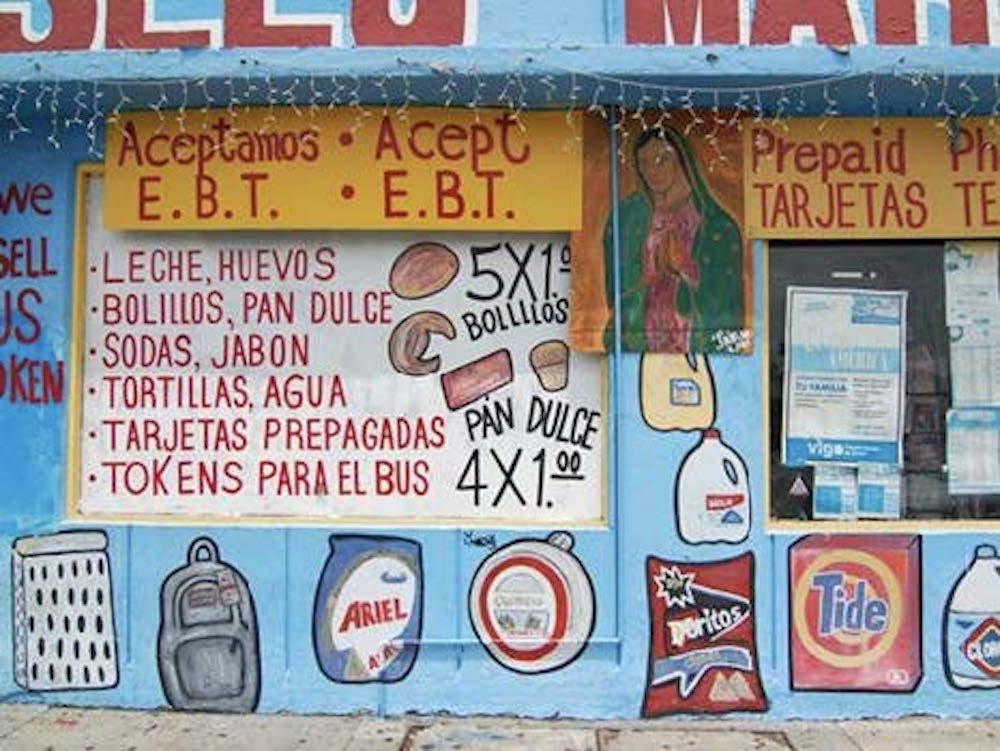
When is a work done? I like that, for you, distance, mystery, and a feeling of unknown are the signals. I tend to call a painting done when every mark and every zone has a role in relationship to all the others; when no part of the painting feels stranded, idle, isolated. Sometimes I aim to make a very sparse painting, and when it’s almost feeling finished I make a mark that throws everything off. Then I need to make forty-two more moves in order for everything to work and by that point it’s a very cluttered painting and that’s just what it has to be. My paintings are additive and cumulative, and it’s difficult for me to remove things or edit back. Rewinding isn’t an option. So if I want a painting with ample negative space or open space, I need to build it up very cautiously. Does your building process involve much unbuilding? Undoing and redoing?
I’ve noticed that if I spend a few weeks painting all day, every day, it becomes especially fun to go on walks because I begin to perceive the environment around me as a composition of small scattered shapes, as in my paintings. I become more likely to see, say, a thin brightly colored ribbon caught in a bush, or a distant traffic cone, or the flight of a small bird. Do you catch glimpses of your sculptures and compositions when you’re moving through the world, outside of your studio?
SZ: I do all the time! Just the other day I saw this group of satellites on the corner of a building and thought to myself - that’s my work!
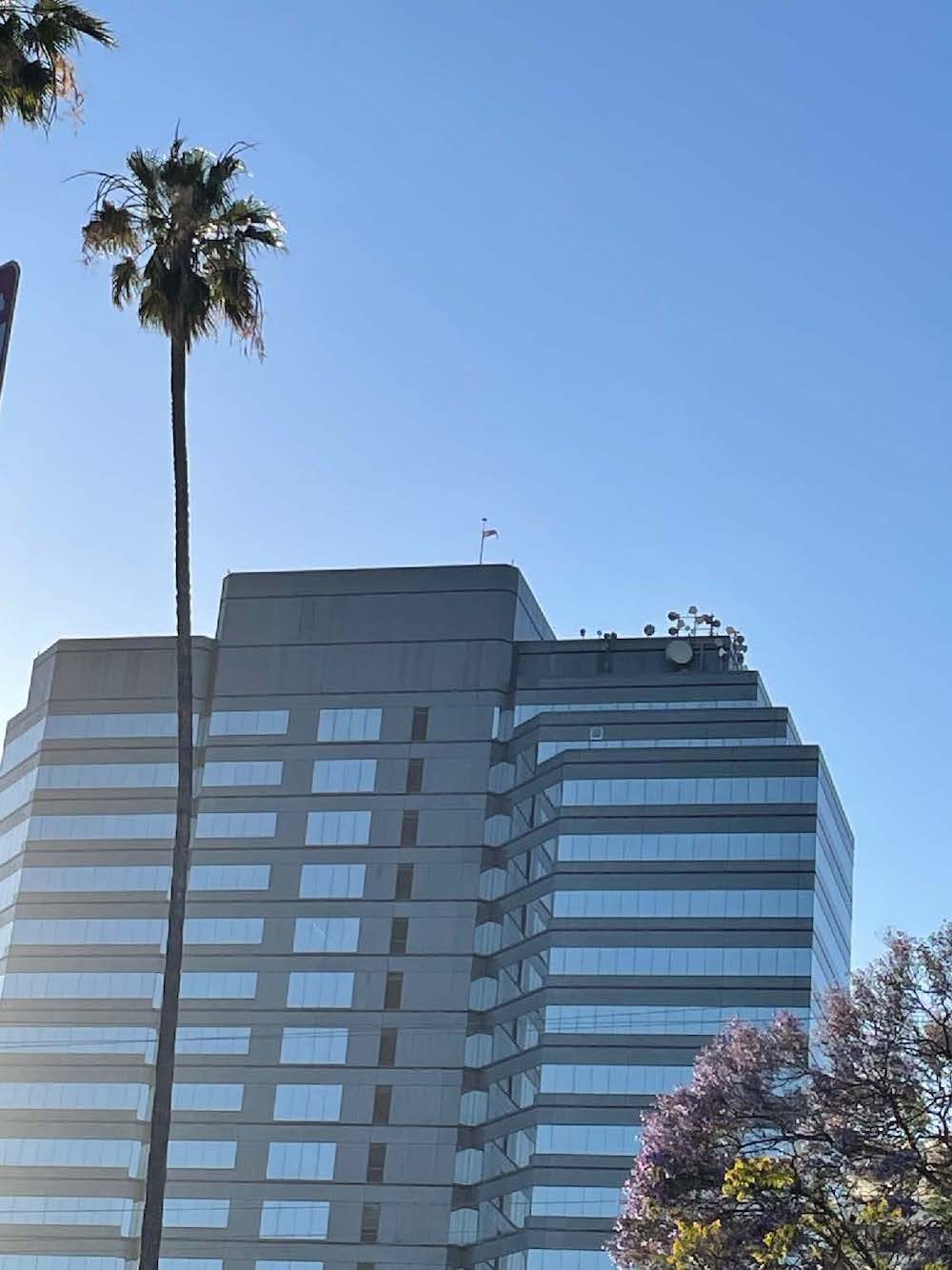
Los Angeles. Photo: Stella Zhong.
Mariel Capanna (b. 1988, Philadelphia, PA; lives and works in Williamstown, MA) received a BFA and Certificate of Fine Art from the Pennsylvania Academy of the Fine Arts, Philadelphia, PA and an MFA from Yale School of Art, New Haven, CT. She has been an artist in residence at the Guapamacátaro Art and Ecology Residency in Michoacan, MX; Skowhegan School of Painting and Sculpture, Madison, ME; and at the Tacony Library and Arts Building (LAB, Philadelphia, PA). Capanna has also been the recipient of the Robert Schoelkopf Memorial Traveling Fellowship and an Independence Foundation Visual Arts Fellowship. She is currently the Mellon Post-MFA Fellow in Studio Art at Williams College, Williamstown, MA.
Stella Zhong (b. 1993, Shenzhen, China; lives and works in New York, NY) received her BFA from Rhode Island School of Design in 2015 and MFA from Yale University School of Art in 2021. Her work has been exhibited nationally and internationally: at Chapter NY and Sculpture Center in New York, NY; FANTA in Milan, Italy; The Aldrich Contemporary Art Museum in Ridgefield, CT: Galerie Marguo in Paris, France; PEANA in Mexico City, Mexico; Guan Shanyue Art Museum in Shenzhen, China and Hive Center for Contemporary Art, Beijing, China; among others.